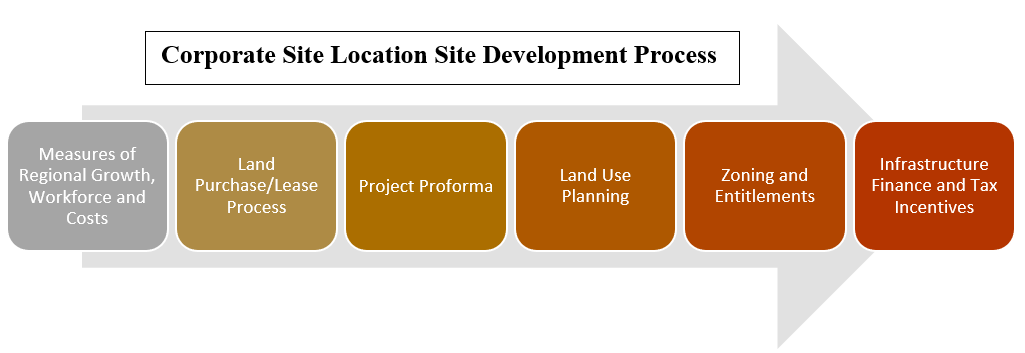The development of a site is a critical step in the corporate site location process. Financing for the public infrastructure tied to the site is generally the most challenging aspect to the site development process.

With buying, building, or renting, a company considering a site for an economic development project needs a pro forma to determine whether the project makes or loses money and what economic development incentives can address potential project costs to make the site more attractive for investment. The pro forma is based upon both expenses and revenues. The development cost budget addresses the expenses of the project and includes all the costs directly related to a project. Hard costs are those expenses directly incurred in connection with the construction of the building, tenant space and other site improvements. They include the contractor, legal, engineer, appraiser, insurer and developer and commercial realtor fees and the cost of all labor and materials provided to the project. Financing and utility charges, impact fees, marketing and operating costs are also included. A contingency reserve is needed to cover any unexpected costs incurred during the development process.
The COVID-19 crisis starkly illuminated key shortcomings – and inequalities – in U.S. infrastructure. While some communities were able to adapt to the pandemic with remote or socially distanced options for work, education, and health care, others lacked the infrastructure needed to do so, compounding the disruptions of the pandemic, and exacerbating existing inequalities, with long-term consequences for American families. One particularly salient infrastructure challenge has been the digital divide and the absence of foundational conditions that enable network connectivity and access. As more and more areas of work and education move online, this divide risks leaving many American families behind. Recognizing these challenges, the American Rescue Plan Act (ARPA) provides $10 B for states, territories, and Tribes to cover the costs of capital projects like broadband infrastructure. The Capital Projects Fund takes critical steps to addressing these challenges laid bare by the pandemic, especially in rural America and low- and moderate-income communities, helping to ensure that all communities have access to the high-quality, modern infrastructure needed to thrive, including internet access. ARPA provides $500 M to establish an emergency pilot program within 150 days after the enactment of ARPA to increase capacity for vaccine distribution, purchase medical supplies, reimburse lost revenue, increase telehealth capabilities, construct temporary or permanent structures to provide healthcare services, support staffing needs for vaccine administration and testing, and engage in other efforts to support rural healthcare facilities in addressing COVID 19.
More importantly, local governments will gain $130.2 B divided evenly between non-county municipalities and counties with counties gaining $65.1 B in direct federal aid to all counties based on the county share of the U.S. population based on the most recent data available from the Census Bureau and non-county municipalities gaining $65.1 B with $45.57 B in direct federal aid for municipalities with populations of at least 50,000, using a modified Community Development Block Grant formula, and $19.53 B for municipalities with populations of less than 50,000 based on each jurisdiction’s percentage of the state’s population. This funding can be used to make necessary investments in water, sewer, or broadband infrastructure—all critical pieces to preparing sites for corporate site location projects.